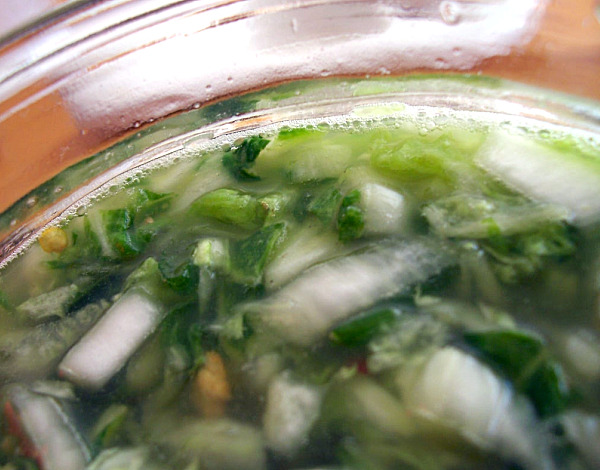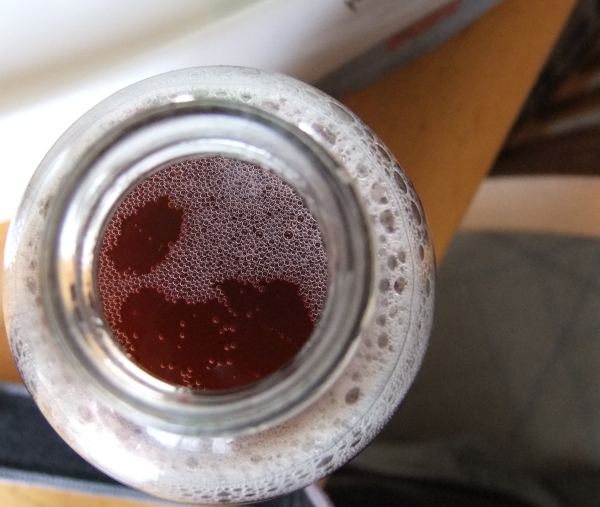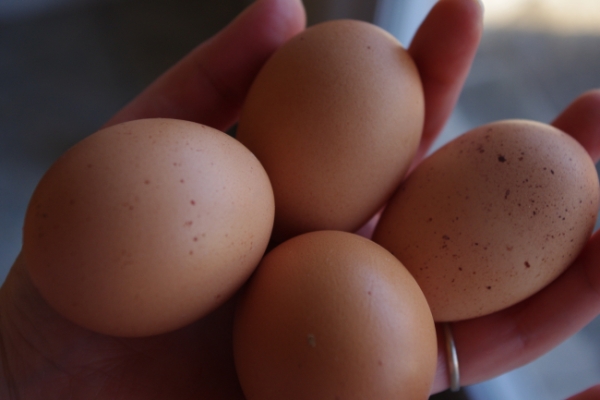Foods to Eat for Winter Wellness

It seemed like a good time to re-run this post which was originally published last year.
Spring is full of raw salads and greens. Summer brings unending tomato salads. Fall is full of lettuce and squash once again. And then there is winter.
If you eat seasonally (and live in a northern climate) then you’ve probably struggled with balancing the heavy foods that our bodies truly need in the cold with our body’s need for enzymes, good bacteria, and fat-soluble vitamins. After all, it’s easy to make a pot of soup, but to balance that with something crisp and light and good for your digestion is difficult when nothing is growing outside.
So when I started planning for our no groceries project and writing Simple Food {for winter} I sat down and made some lists. These lists contain the foods I try to feed my family daily and weekly to keep their digestion easy, their immune systems strong, and their body’s full of vitamins A, D, & K.
But really, it’s more common sense than scientific. When there are no raw vegetables available you eat the vegetables that grew in September and were preserved via fermentation. When you need more enzymes why would you pasteurize your dairy? When you want to keep your vitamin D levels up why not eat eggs, liver, and cod liver oil?
This is how our ancestors ate. It’s common sense, it’s not a fad, and it is the basis for the recipes I share in Simple Food {for winter}. These are the foods that invariably make us feel better. Liver may not be my favorite food, but when turned into a delicious wine and mushroom-studded gravy I’ll eat it. Especially since it contains more available nutrients than a bottle of synthetic vitamins. Oh, and it’s just another part of the animal so if I’m going to eat a steak or a thigh then I should probably be willing to eat the liver too.

Daily
- Cultured & Raw Dairy.We are loving kefir right now for smoothies (pumpkin since we’re out of berries).
- Pastured Eggs. Fried, scrambled, in a frittata, or raw yolks in smoothies – we usually eat at least two per day.
- Lacto-Fermented Vegetables. We eat these every night at dinner and a most of the time with lunch. Sauerkraut, salsa, kimchi, and cortido are like my version of convenience food.
- Lacto-Fermented Beverages. We drink a couple of glasses of either kombucha or water kefir a day. It is so delicious, refreshing, and just makes you feel light and energetic.
- Cod Liver Oil. It’s funny that I’ve talked to several people from my parents or grandparents generation who say "oh yeah, we always took cod liver oil." It’s nothing fancy, just the oil from the liver of a cod – high in vitamins A & D.
- Raw Vegetables & Fruits (if available). – Right now we have two apples. The last carrot was eaten yesterday with sprouted hummus. Sometimes I think "what I wouldn’t give for a big salad," but I know spring will come eventually.
- Butter, Coconut Oil, Lard, and Tallow. I am sad for the people who are afraid of fat. Sad because I was one of them and sad because not eating fat makes people sad. Say it with me "fat is necessary for health and happiness." By happiness I mean that saturated fats and cholesterol actually do things in your brain like make vitamin D prevent seasonal affective disorder and create serotonin that gives you the ability to feel anything but, well, sad.

Weekly
- Organ Meat. We still don’t eat this as often as I think we should, but I’m putting pate on the menu this week and I’ll be doing something with kidneys next week.
- Wild Seafood. Once a week I try to be sure we are eating wild salmon or wild cod (what I have on hand). This means that we actually eat 2 servings of wild seafood per week because of leftovers for lunch.
- Stock. Some weeks we actually eat this daily, but usually 4-5 times per week minimum. It’s easy when you are eating lots of soup and stew.
So, that is my list of foods that I aim to feed my family during winter. Of course the bulk of the actual food on our plate is squashes, potatoes, turnips, pastured meats, and lots and lots of soup. The recipes in Simple Food {for winter} were developed to incorporate these foods into our daily diets.
What do you eat in winter to keep you feeling well?
By the way, I am not a medical expert and don’t pretend to know what they know nor do I prevent or cure illnesses. I just like to share what works for us in the hopes that it may work for you too.


We dug carrots up yesterday that were underneath 18″ of snow….truly amazing how fresh and great they taste when left in the ground. We did the same with Kale on Christmas day…wonderful treat of something fresh and green! Keep writing, I am reading and really enjoy your thoughts!
Mmm… sip, sip. Home-brewed kombucha, an all-time favorite that definitely helps with the digestion and to keep things… “moving!” I have recently been experimenting with flavors by adding powdered fruits to the brew, and my favorite so far is blueberry (I’ve only tried three, and the cherry just ends up super-tart; hubby prefers the goji to the blue).
Often, I wish you would give a little blurb as to what we see in the picture… if I’m not mistaken, that looks like kim-chi, or some such fermented veggie? While not truly “fresh,” I still consider this a raw vegetable, and one of our favorite dishes for quick lunches is to tear a piece of sourdough bread into a bowl, spoon some egg salad over the top of that, and then dish up some LF sauerkraut on top, and eat with a spoon. Even the kids like that one (getting them to drink kombucha is another story…).
We too have some remaining carrots to be pulled, and onions too, but I’m not sure if they’ll be any good, as I accidentally let them get really dry for awhile. They’re currently buried under about a foot of snow, so I’m going to let that melt in and see if it revives anything. We’re not able to do the “no groceries” thing (although we ARE down to every two weeks!), but when we do go, we buy what is in season. We’re missing tomatoes, and can’t wait for summer already!
Thanks for the reminder to try and work in some organ meats… I think I’ll set out some liver tonight to cook up with the hamburger. I typically will cook 5 lbs of hamburger at a time, and then freeze it all in a bag (loosely, so it can be broken up later), scooping out only what I need for whatever meal I’m preparing–it works really well for our family. How simple would it be to sneak some liver in there? Then we’d be having it more than once per week!
Dani – Yes, I probably should put a caption, shouldn’t I? That’s a great idea on the powdered blueberries. My husband is currently loving the grape juice flavor so I don’t think I’ll fight it. Sneaking in liver is a great idea because there’s no mental block of “we’re eating liver, yuck.” :).
“Fat is necessary for health and happiness” Amen! It’s so true. I was afraid of fat once too, but then when I ate more of it and actually LOST weight, I started to think differently about it. Butter, olive oil, nuts, and flax seed oil have nourished my body since, and i feel great because of it.
I’m super lucky that where I live there’s a farmers market in the winter…eating locally is so much easier — especially since we live in an apartment where there is lead in the backyard and haven’t set up a raised bed system yet. After working on a farm this past summer, I think I’d go crazy if I didn’t have fresh milk and eggs and local veggies. Veggies that haven’t driven far to get to my kitchen just plain taste better.
Terrific post, as always, and some great reminders. I am also a huge fan of the winter squashes this time of year – few things better than a big pan full of roasted veggies! It tastes great and the colors feed my color deprivation that comes from living in northern New England in January!
Hiya Shannon!
two tips on the veg front:
It’s winter, so it’s sprouts season down here! Nice, inexpensive freshness. It seems like this time of year is the only time I can tolerate the whole sprouting thing, anyway; it’s nice to see them on the kitchen sink doing their thing. Inexpensive, too, and leaves a nice crunch. I do alfalfa, broccoli, mung beans and garbanzos, and then I spout my grains too for bread.
Winter-sowing is an easy way, too, to get some edible veg and not have to work hard for them (which is why my sprouts sit on the edge of the sink: easy to remember to wash them 2x a day). My daughter put some peas in a clear-lidded blanket box and sprouted them last year in Feb: they were tasty, those things: we ate the shoots. Gotta remember to do that again this year!
I hear you though on the apples. I almost always run out of onions…and then I grow more the next year and *still* run out, grr!
El – Yes, I sprout just about every week for salads and things. I am going to try sowing some more seeds in the hoop house in February to see if we can get anything from them. Thanks for the tips!
We are on the same wave length! I did a similar post today – a combination of food items, herbs and supplements that keep us healthy in the winter!
Glad to find your site in the last few days. It’s beautiful and on the same wavelength as myself and other friends in Central Maryland. In fact, I had just posted on my own blog last night about my first experiment with lacto-fermentation: ginger carrots. I’ve been lucky to find a winter CSA and organized a bunch of families to spread out the few hour drive every two weeks. This is giving us fresh lettuce and a lot of properly cold stored veggies; it’s been a hit within the group. Beyond that, we’re using up stores from the Summer/Fall. Tonight is potato-leek soup and biscuits.
Fantastic overview of your winter diet, Shannon. And pumpkin smoothie…do you have a recipe?
Aimee – I will share one next week :).
I discovered your blog this evening and am enamoured. Looking forward to reading more.
Hi! I love seeing what you are eating on a regular basis. I am just starting to explore gardening and preserving foods, and I hope that next year, I will have a variety of home grown produce ready to get us through the winter.
Thanks for sharing!
I understanc tge differencd between good anc bad fats but just how much fat are we supposed to eat daily? I have no idea if I’m eating too little or too much coconut oil, butter, animals fat, olive oil, etc. Can you give a rough tablespoon amount maybe (the percentage answer I’d too abstract for me)?I’m definitely not afraid of fat but it’s recently occured to me that maybe I’m going a little overboard. There must be an unhealthy limit, right?
Kaitlyn – Hmmm… I’m not sure exactly but I would say we eat a few tablespoons of fat with each meal. I honestly don’t think there’s such a thing as too much good fats because your body will tell you if you are getting too much. Unlike carbohydrates your body has a shut off point for hunger when you have eaten too much protein or fat.
Love the post thank you!! Can you come to my house and help whip us into shape? We are very fortunate to live in warmer climate but it isn’t as easy for me to be in touch with the farmers through winter (we are renters with little to no ability to have our own garden). Maybe I need to let them know this spring that I am willing to keep their garden afloat year round. I would also be very interested in the pumpkin smoothie recipe. And that butter looks delightful! 🙂 Different from pastured butter I get…. where do you find yours?
Mary Kathryn – It is kerrygold cultured unsalted. I get it from Trader Joe’s for a pretty good price. Sometimes I do make my own with raw cream as well.
Roasted chicken from the farm near my in-laws house. I like to cook it on top of a variety of cut root vegetables. It is so warm and filling… and fatty! I am totally with you on the fat. Eating it from good sources is definitely what keeps my energy up when it is cold.
Cassandra – Me too! I do think roast chicken is one of my very favorites.
Mary Kathryn, it looks like Kerry Gold butter, at least based on the shape of the butter and the gold on the outside of the wrapper 🙂 And I have to say it’s my new favorite when I can’t get local raw.
I’m finding that salads just aren’t appetizing in the winter. So refreshing in the summer but just cold and overly crunchy in the winter. I’m craving and enjoying lots of sauteed and steamed greens, eggs, liver pate. Amazing how my body just begs for it all.
Rachel – You’re right :).
I’m sorry for people who are afraid of fat, too! They sure are missing out! Great tips for winter eating. Thanks!
Every morning we are eating oatmeal with loads of pastured butter and some grade b maple syrup. My kids love it. We too eat pastured eggs. Since losing our farm I have had a hard time finding raw milk so I froze some goats milk from this past summer (I milked for a woman who lives down the road). But next year I will have my own goats and we will have plenty of raw cultured stuff! I canned a froze many wonderful fruits and veggies and we are devouring those. I would love to hear how you cook your salmon. I have been making salmon burgers we can’t seem to get enough of them! I think I am going to start sprouting too! Great post always like to hear what others are eating:)
All of your pictures look so good! This year we are eating a lot of winter squash that we have stored in the basement along with vegetables from the garden that I froze, canned tomatoes, salsas, pickles, sauces, etc. We were also super excited and blessed to get an entire locally raised lamb from a family friend as a Christmas gift from my parents, so that is getting us through the winter without having to go to the store for much of anything besides some pantry staples and dairy.
Last year I kept up on making cultured sour cream, kimchi, and salsa, but this year I have been super lazy in the fermenting department with the exception of a quart of preserved lemons. Since we were new to gardening last year I think we preserved too many of some things and not enough of others, so we’ll really need to work on getting into a rhythm this coming year.
I talk to my great aunt a lot about her childhood. She was born in the early 1920’2 and she said her mom (my great grandma) used to make a spring tonic every year for her and her siblings. It was like a smoothy and it always had cod liver oil in it! I think that’s very interesting. I love learning these things!
one more thing as I was reading. Yes, water kefir is very energizing! I drank some last night before going to bed and it took me a while to fall asleep! I have to remember not to drink it in the evening!! : )
Great post! I would love to see a post that elaborates on fat being healthy! It’s so hard to convince people of this! 🙂